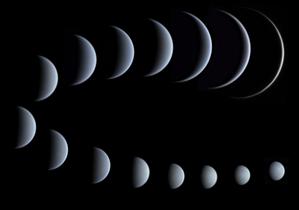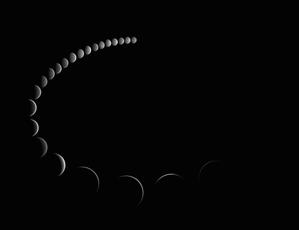Loading...
Related Media
A Matter of Perspective
Caption: This exquisite series of images, captured from Santo Domingo, Dominican Republic, between 17 December 2019 and 25 May 2020, shows the phases of Venus as seen from Earth. As Venus and Earth orbit the Sun, we observe different portions of Venus’s sunlit half, similar to the Moon’s phases. The sequence clearly shows Venus as distant, small, bright and gibbous in the lower frames, and ends with Venus reaching the biggest apparent size of all planets (upper frames), very close to the Sun with a small elongation, and appearing as a thin crescent. In the last frame, only 2.8% of the planet’s surface is illuminated.
Credit: Christofer Baez/IAU OAE (CC BY 4.0)
Credit: Christofer Baez/IAU OAE (CC BY 4.0)
License: CC-BY-4.0 Creative Commons تخصیص 4.0 بینالمللی (CC BY 4.0) icons
Phases of Venus
Caption: This is a mesmerising series of images of Venus captured from Surgères, Charente-Maritime, France, over a period of six months in 2015. The phases appear similar to the phases we see of our own Moon and occur for similar reasons. Only half of Venus is illuminated by the Sun and, from Earth, we can sometimes only see part of that illuminated half, depending on the relative positions of the Sun, Earth and Venus. Both Mercury and Venus exhibit phases because their orbit is between the Sun and the orbit of Earth. Depending on the position of Venus relative to the Sun and Earth, Venus goes through its phases over a period of time. This sequence of images beautifully showcases the transition from the ‘gibbous’ to the slender crescents. The use of infrared filters helped to capture Venus's dense perpetual cloud cover during daylight in sharp detail, providing a glimpse into the mysterious nature of the planet’s atmosphere.
Credit: Stephane Gonzales/IAU OAE (CC BY 4.0)
Credit: Stephane Gonzales/IAU OAE (CC BY 4.0)
License: CC-BY-4.0 Creative Commons تخصیص 4.0 بینالمللی (CC BY 4.0) icons
Venus and Mercury Trails
Caption: In this composite image, both Mercury (left) and Venus (right) can be seen heading into the sunset. The phases of each are beautifully captured as they descend. Not all planets or moons in the Solar System show phases as viewed from Earth. This phenomenon occurs because the orbits of Venus and Mercury are positioned between Earth’s orbit and the Sun, sometimes allowing us to see only part of the illuminated portion of each planet. These phases are similar to the phases we see of our own Moon.
Credit: Marcella Giulia Pace (CC BY 4.0)
Credit: Marcella Giulia Pace (CC BY 4.0)
License: CC-BY-4.0 Creative Commons تخصیص 4.0 بینالمللی (CC BY 4.0) icons











